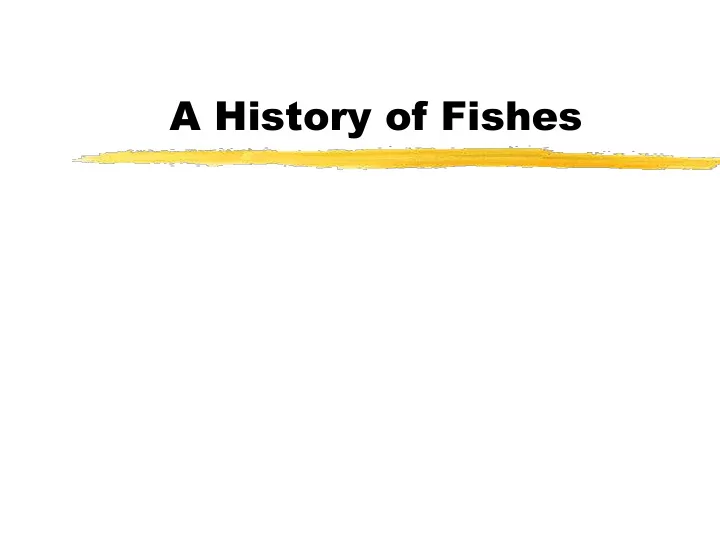

A History of Fishes
Evolutionary History Fish have adapted to a wide range of environmental parameters • Temperatures -1.8°C - 40°C • pH 4 - 10 • O 2 Concentrations 0 - Saturation • Salinity 0 - 90 • Depths 0 - 7000m A History of Fishes 2
Diversity and Evolution The diversity of fishes reflects their long evolutionary history A major challenge to ichthyologists involves unraveling the evolutionary pathways of both extant (living) and extinct taxa A History of Fishes 3
Evolutionary History
Conodonts A History of Fishes 6
A History of Fishes 7
Ostracoderms Characteristics: 1. Lack of jaws 2. Lack of paired fins 3. Bony armor 4. Internal cartilaginous skeleton Modern day representatives of this group: • Class Pteraspidomorphi (hagfishes) • Class Cephalaspidomorphi (lampreys) A History of Fishes 8
Ostracoderms A History of Fishes 9
Early Jawed fishes Gnathostomes • Jaws are probably the greatest advancement in vertebrate evolution o This allowed for an explosion in diversity due to the different prey items that can be processed A History of Fishes 10
Placoderms Diverse group with a bizarre appearance 1. Jaws 2. Dermal body plates 3. Internal skeleton 4. Paired fins Some were over 6 meters in size and possessed a craniovertebral joint A History of Fishes 11
Dinichthys Placoderms Craniovertebral joint A History of Fishes 12
Placoderms Gemuendina Bothriolepis A History of Fishes 13
Class Chondrichthyes Arose during the early Paleozoic and followed a very different line of evolution • Cartilaginous fishes • 2 distinct lines of evolution; the connection between the two is poorly understood o Fossil record is poor, since cartilage does not readily fossilize Characteristics A History of Fishes 14
Class Chondrichthyes A History of Fishes 15
Class Chondrichthyes Two distinct evolutionary lines 1. Subclass Elasmobranchii o Sharks, skates, and rays A History of Fishes 16
Class Chondrichthyes Two distinct evolutionary lines 2. Subclass Holocephali o Ratfishes or chimaeras A History of Fishes 17
Class Osteichthyes Bony Fishes
Subclass Sarcopterygii (Lobe-finned fishes) Present day lungfishes and coelacanths • This group has paired fins which actually have muscle in the fin itself It is this class which is believed to have given rise to the amphibians A History of Fishes 19
Subclass Actinopterygii (Ray-finned fishes) The most successful of all the modern fishes 1. Triangular dorsal fin 2. Paired fins without fleshy lobes 3. Ray-finned A History of Fishes 20
Subclass Actinopterygii (Ray-finned fishes) Infraclass Chondrostei • Sturgeons, and paddlefishes A History of Fishes 21
Subclass Actinopterygii (Ray-finned fishes) Infraclass Neopterygii • Remaining 27,000+ bony fishes A History of Fishes 22
Evolutionary Review Ostracoderms - primitive jawless fishes No living representatives, possible relatives include hagfish and lamprey Class Chondrichthyes - cartilaginous fishes Class Placodermi - first jawed fishes No apparent descendants Subclass Elasmobranchii - Subclass Holocephali - sharks, skates, & rays ratfishes Subclass Sarcopterygii - lobe-finned fishes Present day lungfishes and coelcanth Class Infraclass Chondrostei - Osteichthyes - sturgeons & paddlefishes bony fishes Subclass Actinopterygii - Infraclass Neopterygii - ray-finned fishes A History of Fishes 23 remaining bony fishes
Population Distributions By volume, 97% of all water on earth is found in the worlds oceans • 58% of all fish species are marine • 41% are freshwater species • 1% move between the two habitats Marine Habitat • 13% of marine species associate in open water • 78% live over the continental shelf A History of Fishes 24
Physical Properties of Water Water is 800x denser than air! Water is incompressible Water is a universal solvent A History of Fishes 25
Nomenclature The most frustrating aspect of ichthyology is the constant changing of scientific names These names change for several reasons Changes are necessary as new information is discovered concerning evolutionary history A History of Fishes 26
Species Names Each spp. is assigned a unique two part scientific name • Longnose Dace Rhinichthys cataractae (Valenciennes 1842) • Names are usually descriptive in some way o Rhinichthys - nose-fish o cataractae - the fast water in which it lives A History of Fishes 27
A History of Fishes 28
Recommend
More recommend